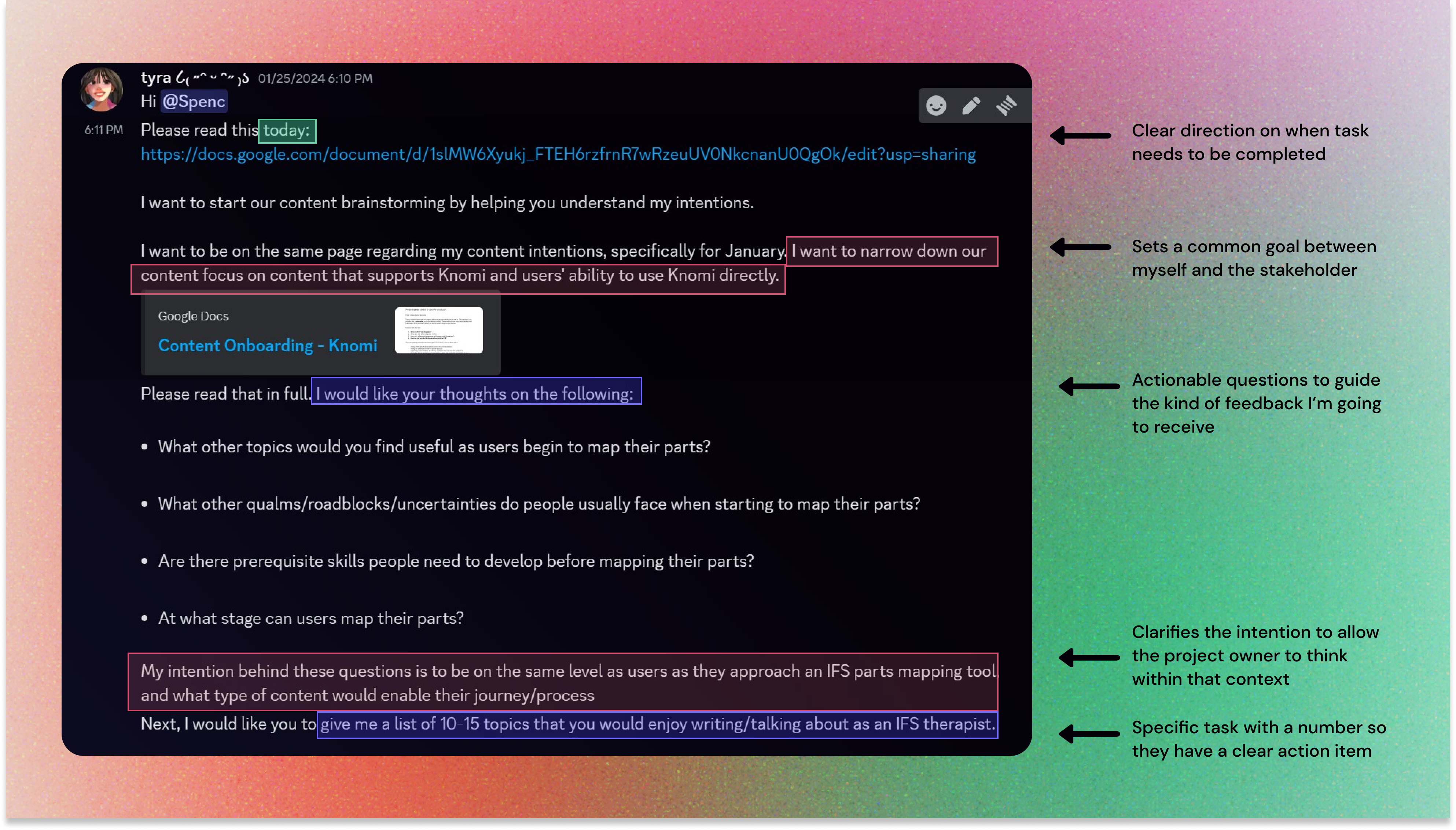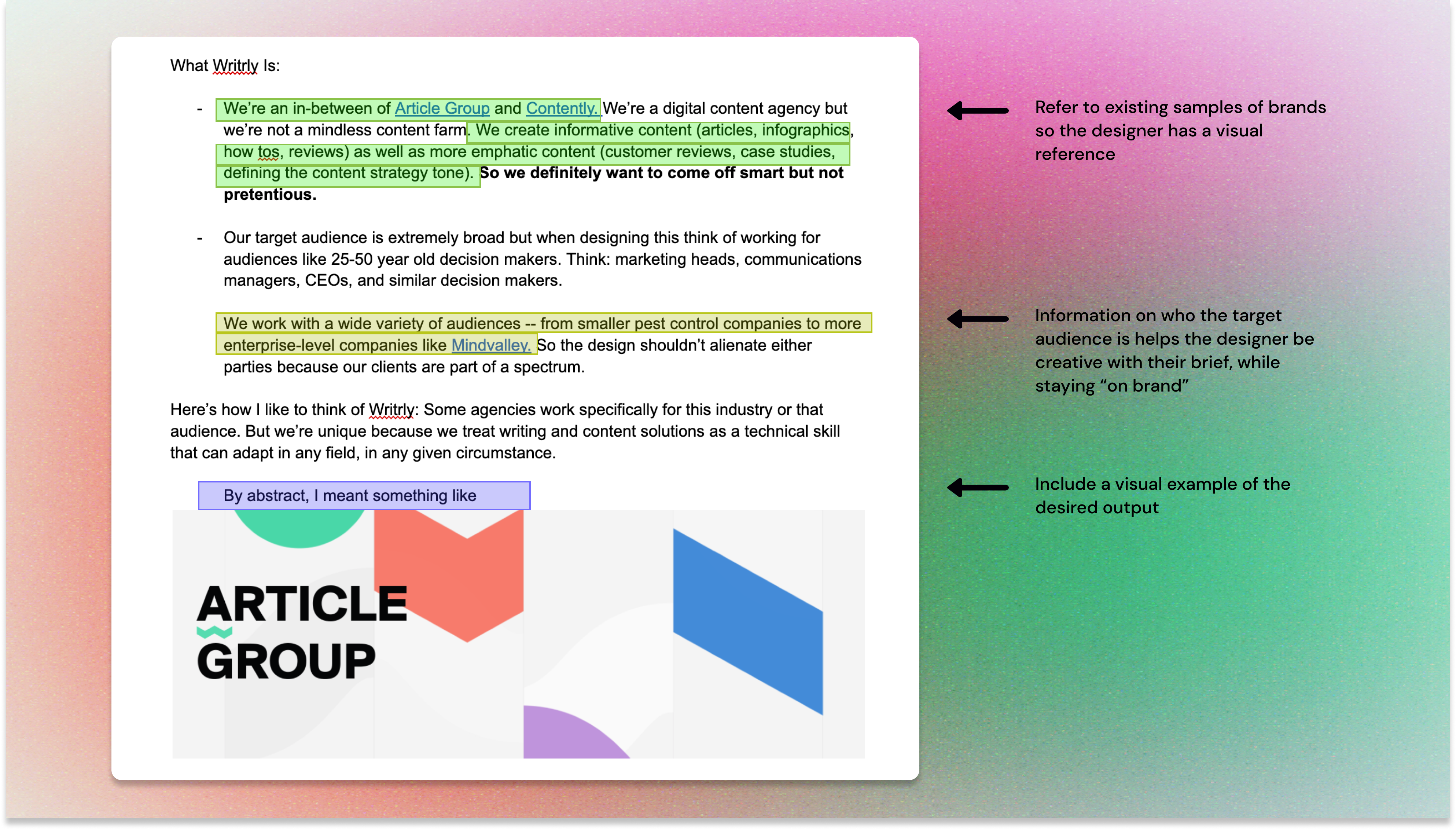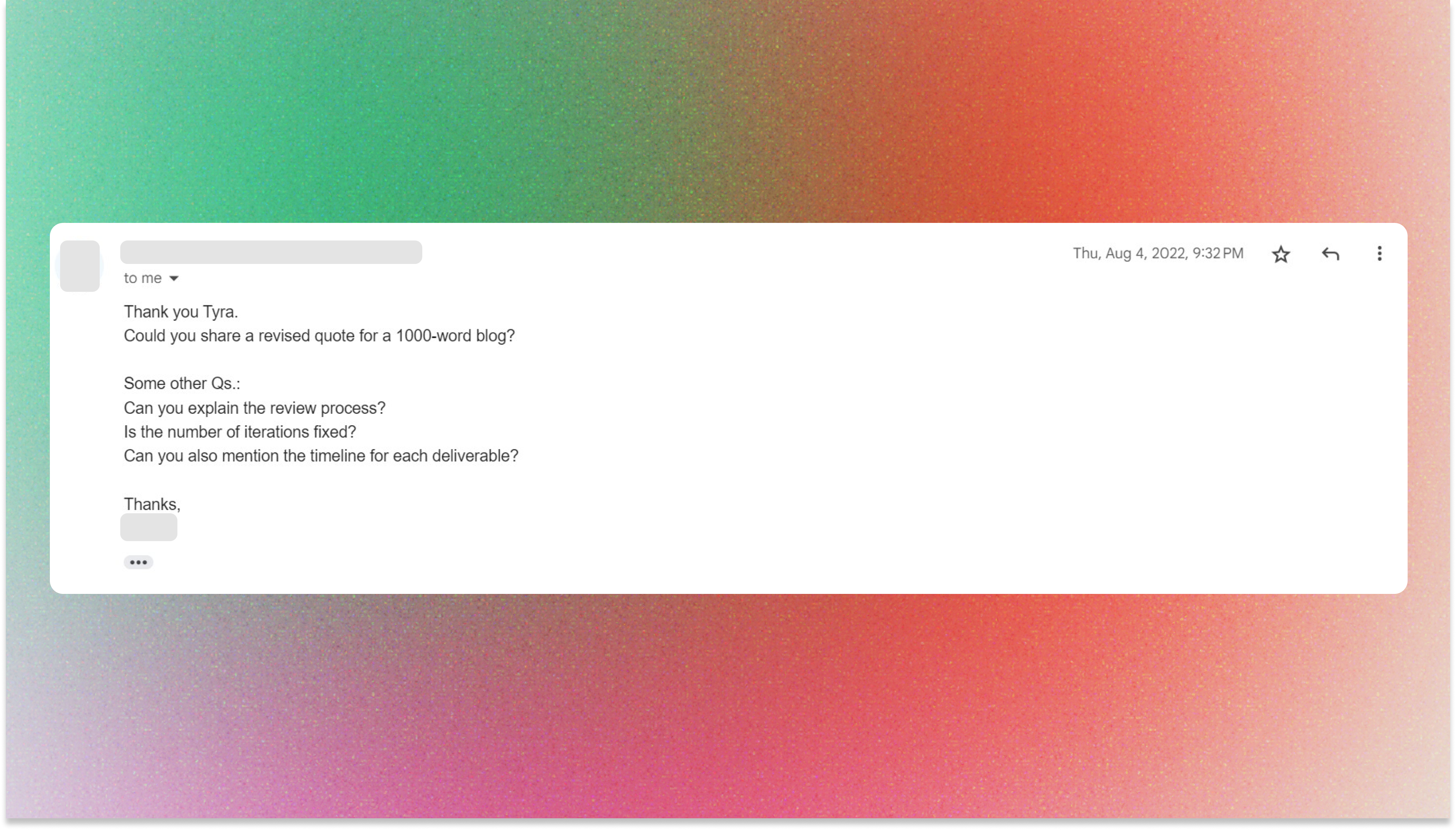Working cross-functionally within a team is a multivariate challenge that I enjoy solving.
With effective communication, I’ve solved problems in remote work settings like:
- Helping non-techy/non-corporate stakeholders translate their observations about the community into user requirements
- Developing a content strategy that directly supports a B2B firm’s everyday functions
- Creating systems and documentation to prevent a client from churning
Collaborating with stakeholders in different timezones has taught me a couple of skills:
- The importance of providing context to expedite decision-making
- Providing guardrails for feedback to help project owners and stakeholders provide tactical advice
- Using curiosity openly and never assuming you’re on the same page to prevent miscommunication
- Learning what your customer wants to hear - and meeting them halfway
Here are some concrete examples of me communicating with project owners and team members as a team lead:
Within the team
Including subject matter expertise in the content

My goal
I was collaborating with a subject matter expert who interfaced directly with our end-users.
My research showed that users were constantly asking for resources to help them on their journey: how to videos, articles, access to free information from subject matter experts.
My goal was to create resources that would directly address the community’s needs, and collaborate on the subject matter expert to flesh out a nuanced, community-informed content strategy.
How I achieve this goal
- Provide specific questions for them to consider. Itemize the feedback that you are looking for.
Why: This reduces scope creep and narrows down their focus on what you think is important as an individual contributor. It’s not uncommon for project owners to want to be involved in every single aspect of the project. Having too many voices in a project isn’t always helpful and typically ends in delays or an unfocused strategy.
- Mention the intention or strategy behind it to provide a common starting point.
Why: Sometimes strategies don’t match because the underlying goal or intention is not in alignment. Mentioning that upfront sets a clear, unambiguous starting point.
- Even during the exploration phase, provide specific instructions they can react to.
Why: If they say “I’d rather do a podcast than a blog”, that is infinitely more useful than two days of back and forth “brainstorming” what you could do together.
Results and thoughts
The subject matter expert said he was struggling to come up with topics that related to the feature. This is a clear signal to me that I can take the lead on content ideation moving forward.
I shared a popular video that is commonly shared by peers within the community to see what he thinks of it. He mentioned that he did not resonate with the tone.
This gave me some directions on the type of content he was willing to make. Finding a format the subject matter expert is most comfortable with is key to content sustainability, at least in the early stages of laying out a content strategy.
Moving the needle in a time-constrained development project

My goal
I was working with a full-stack developer to get Writrly’s site up. We were working asynchronously and had a tight deadline to follow.
My goal was to work with the developer to transform the static UI/UX screens into a dynamic website.
How I achieved this goal
- Don’t assume you have an equal understanding of jargon, especially if you’re a non-native in the field.
Why: I find this is especially true when working with developers - I could have a completely different understanding of a technical jargon or term than they do. Provide screenshots and screen recordings to eliminate miscommunication.
- Create a list of items to provide a clear scope of the tasks, as well as an itemized overview of the project.
Why: This keeps the team in-sync regarding updates and edits to the project, making cross-collaboration easier. This is especially useful in situations where the work of ICs feed into each other.
Results
We finished the 10+ page website within 2 weeks of development. Granted it was a WP-based site, which meant it was faster, but it was equipped with a dynamic CMS, a payment portal, and an email forwarding service.
The systematic feedback made it infinitely quicker and easier to collaborate - even with the 6 hour time difference.
Assigning a creative task to an IC

My goal
I was working with a newly hired designer in developing marketing assets. We didn’t have a formalized brand identity and at the very most had a color palette we used on our website.
My goal was to provide a creative brief where I provided just enough context to give her a starting point, while encouraging her to explore her own creativity and sensibilities to start co-creating a brand identity.
How I achieved this goal
- Mention the end-user who is going to be interacting with the design
Why: Mentioning who the end-user is gives them a starting point when it comes to doing their own design research. Having a clear target in mind helps ICs more connected to the project and ensures the design is rooted in the audience.
- Provide visual examples and explain what you like and don’t like in terms of composition, color, structure.
Why: This narrows down their scope of options and ensures that the final output is more or less aligned with what you’re looking for. This information upfront saves a lot of revision time in the future.
Results and thoughts
We were able to land on a visual identity within the same week of the assignment. We did a review session mid-week and she polished the marketing assets according to my feedback.
Because she was essentially a collaborator on the visual identity, she internalized my preferences and sensibilities for the brand identity. By her second week, she created a pitch deck for sales with little to no guidance from me.
With clients and external shareholders
My time at Writrly was split between coordinating with the internal team, and doing outbound sales. I connected with director of/marketing VPs, founders, and SMB owners who didn’t have their own content team.
Here’s how I typically approach prospects who are interested in getting a subscription, but still has reservations about the process:

My goal
The client is an AWS service provider and works with high-budget startups and organizations in the US.
Although she seemed interested in our services, she had some concerns about the cost of the service.
My goal was to understand her reservations, address her concerns, and convert her to a paying customer.
How I achieved this goal

Throughout the conversation, she told me that her company typically enlisted developers to write content every now and then - which I assumed took time away from their actual roles.
As the Head of Marketing, this was going to be her first content hire.
From her questions, I could glean a couple of things:
- She’s looking to understand the pros and cons between a contractor and an in-house hire. Was our review process going to be strict and controlled enough as an in-house production? What was quality assurance like?
- Did we have a system in place to accommodate edits, changes, and revisions? How is a contractor going to accommodate the (understandable) changes that happen in internal collaboration? Did we have fees for that?
- How efficient was this service going to be? Would it slot in well with their current schedule?
I answered her questions specifically, while expanding on what I thought were the “question behind the questions”.

Results
In that same email thread, the client got back to me and signed a $500/month subscription with us.

What is your approach to communicating with users/customers?
“Don’t ask for anything in return - just give value and build a relationship with them first.”
This is advice that I frequently see being exchanged online. It’s great advice, but as with most stuff I see circulating on Twitter and LinkedIn, I think it’s usually said way out of context.
This ideal that B2B buyers buy based on a built relationship has to be one of the biggest lies ever. It’s not a relationship people are looking for - it’s resonance and trust.
When they feel like you understand what their problems are and they hear you talk about their problems in their own language, you’re basically telling them: “I know exactly what you’re going through - and I have experience on how to fix that.”
How does that translate to positioning and messaging?
- Understanding where your users are getting their information, the meta in that community, and addressing their concerns
- Understanding what your customers already know - and what they’re likely to ask to provide value and pose your brand as an authority in a niche
